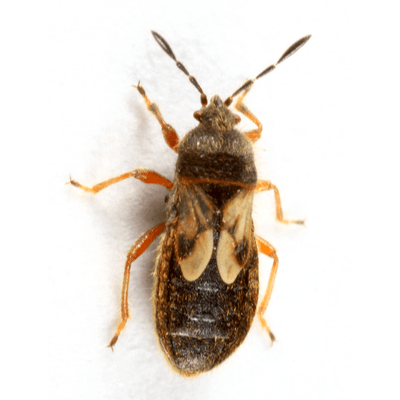
Color: Have black bodies and fully developed wings that appear frosty-white except for distinctive triangular black patch-like markings at the middles of the outer margins. Adults appear as either long-winged or short-winged forms. Newly hatched nymphs appear orange red with a pale whitish band across their abdomens. As they molt through five growth stages (instars), nymphs gradually change color from red to orange to black and develop wing pads as they develop.
Size: Adult chinch bugs are almost 3/16-inch long
Manufacturer Recommended Products And Treatment For Chinch Bug Control
Pests need food, water, and shelter. Often the problem may be solved just by removing these key items. Before even thinking about chemical pest control, it is important to be aware of
| Conducive Condition | Recommendation | |
| 1 | Tree branches on house | Keep tree branches away from house to reduce pest access |
| 2 | Firewood next to foundation | Keep firewood away from house to reduce pest harborage |
| 3 | Debris on crawlspace/next to foundation | Remove wood debris to reduce termite ha rborage area |
| 4 | Excessive plant cover, stump, etc. | Providing spacing between plant cover and structure |
| 5 | Soil above the foundation Ii ne | Keep soil below top of foundation to reduce harbo rage areas |
| 6 | Wood-to-ground contact | Keep soil from touching wood to eliminate termite access |
| 7 | Debris on roof/full gutter | Keep gutter & roof free of debris to reduce insect harborage |
| 8 | Standi ng water near/under structure | Eli minate standing water to reduce pest harbo rage |
| 9 | Mo isture problem under structure | Increase ventilation to reduce pest harbo rage area |
| 10 | Openi ngs at plumbi ng & electronics | Seal opening to reduce pest access |
| 11 | Excessive gaps at windows/doors | Seal gaps to reduce pest access |
| 12 | Lea ky plumb ing fixtures | Repair to reduce moisture for pests |
| 13 | Keep garbage cans covered | Covered to reduce attraction of insects of vertebrate pests |
| 14 | Mo isture damage wood | Repair rotten or damaged wood to reduce insect harborage |
| 15 | Grocery bags stored improperly | Seal paper sacks in containers to reduce i nsect ha rborage areas |
| 16 | Pet food unsealed or left out | Keep pet food in sealed containers and unavailable to pests |
| 17 | Excessive storage conditions | Keep storage areas uncluttered and manageable |
| 18 | Debris below kick plates | Remove kick plates to reduce rodent harborage |
About Chinch Bug Control
Small chinch bugs can harm lawns, especially in warm, dry weather. These insects feed on grass, turning it yellow and killing it. Early detection and treatment are key to chinch bug control. Integrated pest management—chemical and non-chemical—is advised. Proper lawn care, including soil health and moisture levels, helps avoid outbreaks. Broad-spectrum insecticides can be useful, but they should be used as part of a lawn care plan to promote grass health and resiliency.
Getting to Know Chinch Bug Life Cycle
Effective pest management requires understanding the chinch bug life cycle. Chinch bugs have egg, nymph, and adult phases. Late spring is when females lay eggs in grass thatch. Nymphs hatch from these eggs and rapidly grow through numerous phases, changing color from brilliant red to black as they mature.
This cycle can take four to six weeks, depending on temperatures, and numerous generations can occur in a season in warm climates. Understanding these stages lets you time interventions to interrupt the cycle and control the population.
Searching for Chinch Bug Control Near Me?
Effective chinch bug management requires local pest control. Since local weather might alter the pest's life cycle and treatment efficacy, homeowners should seek out local chinch bug goods and services. Finding "chinch bug control near me" can lead to customized products and services.
Numerous local extension services also advise on pest control product selection. We recommend choosing any Pest Control Products Depot treatment or calling us and boom! No more chinch bugs. Visit this page to browse our items!
The Best Chinch Bugs Lawn Treatment Products
Most lawn treatments for chinch bugs include pesticides that kill both nymph and adult bugs. Effective products contain bifenthrin, permethrin, or deltamethrin. Use insecticides according to package guidelines to prevent killing beneficial insects and get the greatest results. For a more sustainable strategy, neem oil or insecticidal soaps may work, but they require more frequent use.
Chinch Bug Damage Prevention Strategies
Prevention is the best chinch bug control method. A healthy grass requires adequate watering, mowing at the right height, and aeration to avoid compact soil that chinch bugs like. Dethatching and fertilizing can also repel chinch bugs. Without chemical treatments, resistant grasses and natural predators like birds and beneficial insects can reduce chinch bug populations.
Why Choose Pest Control Products Depot to Control Long Fast Bugs?
Pest Control Products Depot has chemical and organic chinch bug remedies. Their products are chosen for efficacy and usability, giving you the best possibilities. Pest Control treatments Depot also provides thorough product descriptions and application instructions to assist you choose the right treatments for your lawn. They can help keep your grass healthy and chinch bug-free, whether you're dealing with a sudden outbreak or preventing one.
Buy Chinch Bug Pest Control Online Now!
Pest Control Products Depot has a complete online store for chinch bug treatment solutions. You may buy insecticides and pest control treatments that kill chinch bugs. Their online platform makes it easy to find what you need to solve your pest control problems quickly with thorough product information, customer reviews, and easy navigation. If you need immediate or preventative treatment, Pest Control Products Depot has high-quality products and reliable delivery.
9 products










